![]()
![]()
![]()
Use LEFT and RIGHT arrow keys to navigate between flashcards;
Use UP and DOWN arrow keys to flip the card;
H to show hint;
A reads text to speech;
75 Cards in this Set
- Front
- Back
- 3rd side (hint)
|
Organization within eukaryotic cell is random (T/F)
|
False
|
|
|
|
What is cytoskeleton important in?
|
- cell shape
- cell motility - movement / position of organelles - movement of materials within cell - movement of chromosomes during mitosis |
|
|
|
What are the 3 ways to import proteins onto organelles?
|
-Transport through nuclear pores
-Transport across membranes -Transported by vesicles |
|
|
|
What is protein sorting?
|
transfer of proteins into compartments where they are needed
|
|
|
|
Synthesis of virtually all proteins starts in cytosol, on?
|
Free ribosomes
|
|
|
|
What is the signal sequence?
|
Stretch of amino acids, 15-60 AAs long, that directs proteins to particular organelles by binding to it
|
|
|
|
Signal sequences for?
|
nucleus, mito/chloro, peroxisomes or ER
|
|
|
|
Signal sequences are usually removed after sorting (T/F)
|
True
|
|
|
|
When does the protein go to the wrong "address"?
|
When deletion occurs, or when sequence goes to a wrong protein
|
|
|
|
A nucleus has a double membrane called?
|
The nuclear envelope
|
|
|
|
Proteins to be imported to the nucleus have a ______ localization sequence.
|
nuclear
|
|
|
|
Do nuclear transport receptors get recycled?
|
Yes! Nuclear transport receptors bind with the nuclear protein with the nuclear localization signal and brings it through the nuclear pore. The receptor then goes back through the pore and binds with a new protein.
|
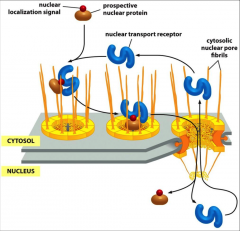
|
|
|
What are nuclear pores?
|
Gateway to the nucleus
|
|
|
|
_______ molecules (even _______ proteins) freely pass through nuclear pores.
|
Small, small
|
|
|
|
The passage of a larger protein is an ______ process. Which means?
|
Active.
Energy is required |
|
|
|
What is a nuclear localization signal?
|
An amino acid sequence that ‘tags’ a protein for import into the nucleus by nuclear transport
|
|
|
|
What is a nuclear export signal?
|
tags a protein for export
|
|
|
|
What moves out of a nucleus?
|
Mature, properly made mRNA, ribosomal RNA
|
|
|
|
What moves into the nucleus?
|
-histones
-ribosomal proteins -proteins required for transcription & DNA replication -dNTPs, rNTPs (purine, pyrimidine) |
|
|
|
Chloroplast has a third membrane (T/F)
|
True
|
|
|
|
What is chloroplast's 3rd membrane called?
|
Thylakoids
|
|
|
|
Mitochondria and chloroplasts have their own genomes and ribosomes, most of their proteins are encoded by _______ genome, so it must be _______.
|
Nuclear, imported
|
|
|
|
Proteins destined for mitochondria/chloroplasts are made by ________ in the cytosol.
|
Free ribosomes
|
|
|
|
Proteins must be _________ to be imported, then upon import, fold and have the signal sequence removed (import of proteins into mitochondria)
|
unfolded
|
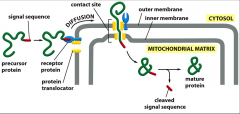
|
|
|
Where does the signal sequence attach to on the protein going into the mitochondria/chloroplast?
|
N terminus
|
|
|
|
Proteins must be moved across both ______ and ______ membranes at special sites where layers are in contact.
|
outer, inner
|
|
|
|
Explain the process of import of a protein into mitochondria.
|
1. signal sequence (SS) binds at N terminus of the protein (protein is unfolded)
2. SS binds with receptor protein on the outer membrane 3. The protein translocation moves the protein to the contact site 4. Protein comes off the receptor protein and goes through the contact site (both membranes) 5. Once in the mitochondrial matrix, the protein folds and the signal sequence is cleaved 6. Now the protein is mature |
|
|
|
Synthesis of all proteins starts on free ribosomes (T/F)
|
True
|
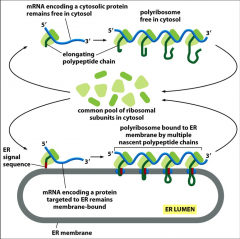
|
|
|
ER is most extensive of endomembrane system (T/F)
|
True
|
|
|
|
ER serves as entry point for which organelles?
|
-proteins for ER
-Golgi -lysosomes -endosomes -cell surface -secretory proteins |
|
|
|
What is the lumen of the ER?
|
The space enclosed by the membrane of the ER
|
|
|
|
Once in ER (in membrane or lumen), proteins will never re-enter cytosol (T/F).
|
True
|
|
|
|
What are the 2 types of proteins transferred to the ER?
|
-Water soluble proteins translocated completely across into the lumen
-Transmembrane proteins translocated only partially across |
|
|
|
What are water soluble proteins destined for?
|
Destined for secretion or the lumen of an organelle
|
|
|
|
What are transmembrane proteins destined for?
|
Destined for plasma membrane, ER membrane, or membrane of another organelle
|
|
|
|
The ER signal sequence and an _______ direct ribosome to the ER
|
Signal recognition particle (SRP)
|

|
|
|
The signal recognition particle (SRP) go to the SRP receptor in the ER membrane. What happens next?
|
SRP is displaced and recycled. The ER signal sequence on the growing polypeptide chain binds to the translocation channel and the protein goes through it into the ER lumen
|
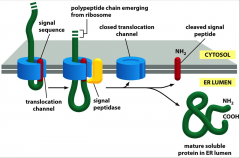
|
|
|
The signal peptidase then closes the translocation channel. Mature soluble protein is now in the ER lumen (T/F)
|
true
|
|
|
|
What happens in a Single-Pass Transmembrane Proteins?
|
The stop codon in the protein enables the signal peptidase to come early and close the translocation channel which essentially traps the protein within the double membrane.
This is called a mature transmembrane protein. |
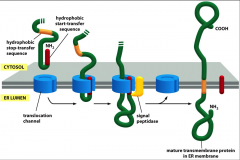
|
|
|
What is a vesicular transport in respect to proteins?
|
Transport vesicles carry soluble proteins, and membrane proteins between compartments
|
|
|
|
What are soluble proteins?
|
It's mature proteins in the lumen of an organelle
|
|
|
|
What are vesicular transport in general?
|
Outward from ER, to the Golgi, to other organelles or plasma membrane
Inward from plasma membrane, endosome, lysosome |
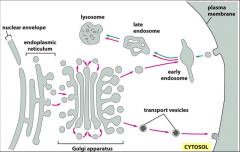
|
|
|
Vesicle budding is driven by formation of what?
|
protein coat
|
|
|
|
What is an example of vesicle budding?
|
Clathrin-Coated Vesicles
|
|
|
|
What is Clathrin coated vesicles?
|
- mediate transport from outward face to Golgi and inward from plasma membrane
- clathrin forms ‘basket’ that gives vesicle shape - ‘adaptins’ recognize and capture specific cargo for transport |

|
|
|
What are the functions of the rough ER?
|
Synthesize proteins for:
-secretion/export -membrane insertion -lysosomes |
|
|
|
Golgi apparatus function?
|
Kinda like a mailbox office. Collects, packages, and distributes.
-Modification of new proteins arriving from ER: -peptide chains shortened by proteases (enzyme that breaks down proteins and peptides) -amino acids modified -CHO groups that were added in ER modified or removed -glycosylation (adding sugar to protein) -different CHO groups added to different AAs (ser, thr) “O-linked glycosylation” |
|
|
|
Where does the secretory pathway occur?
|
ER
|
|
|
|
Most proteins are covalently modified in the ER (T/F)
|
True
|
|
|
|
Formation of what bonds happens between proteins in the ER?
|
disulfide (very strong)
|
|
|
|
What do the additions of sugar groups do in the secretory pathway?
|
various functions depending on protein.
-protect protein from degradation -keep protein in ER until properly folded -help direct protein to proper organelle (act as transport signal for packaging into appropriate vesicles) -if displayed on cell surface, cell-cell recognition |
|
|
|
What is glycosylation?
|
As a growing peptide enters ER, ‘prefab’ carbohydrate group attaches to amino (NH2) groups of asparagine (Asn) side chains
“N-linked glycosylation” |
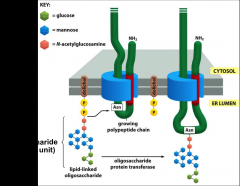
|
|
|
Greater protein flux increases what?
|
The size of ER
|
|
|
|
Only properly folded proteins are allowed to leave the ER (T/F)
|
True
|

|
|
|
What is greater protein flux?
|
When protein production exceeds capacity to keep up with folding
|
|
|
|
What happens during greater protein flux?
|
Misfolded proteins accumulate and signals to make more ER
|
|
|
|
What happens if cells still can't keep up?
|
The unfolded protein response (UPR) will trigger cell death/apoptosis
|
|
|
|
What happens during the modification and sorting in the Golgi Apparatus?
|
Organized into functionally distinct compartments with cis (entry) face closest to ER, trans (exit) face at other end
|
|
|
|
Series of flattened sacs in the golgi apparatus are called?
|
cisternae
|
|
|
|
What is cis?
|
newly formed, face closest to the ER
|
|
|
|
What is trans?
|
breaking away, faces the end further from the ER
|
|
|
|
The most complex polysaccharides synthesized in?
|
Golgi apparatus:
-glycos amino glycans in extracellular matrix (animals) -pectins, hemicellulose (plant cell walls) |
|
|
|
What is phagocytosis?
|
Allows cells to take up large particles (ie. yeast being engulfed by bigger cell)
|
|
|
|
What is constitutive secretion?
|
Proteins are sorted into vesicles in the Golgi and move directly to the cell surface and fuse with the plasma membrane (exocytosis), resulting in the release of soluble proteins to the plasma membrane.
UNREGULATED membrane fusion. |
|
|
|
What is regulated secretion?
|
Differs in that the proteins are stored in secretory vesicles that later fuse with the plasma membrane in response to a specific signal.
REGULATED membrane fusion |
|
|
|
What are Endocytic Pathways?
|
The process of taking substances into cell by surrounding them with membrane (absorb or engulf)
|
|
|
|
What are the 2 main types of vesicles based on the size formed?
|
Pinocytosis and phagocytosis
|
|
|
|
What is pinocytosis? [endocytic]
|
"cell drinking" - tiny vesicles formed called endosomes which is done by all eukaryotic cells.
-‘bulk’ – any molecules present in enclosed fluid enter cell |

|
|
|
Phagocytosis is? [endocytic]
|
"Cell eating"- much larger vesicles called phagosomes. Only done by specialized cells.
-eats particles, other cells, debris |
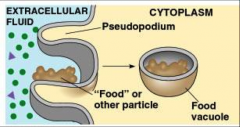
|
|
|
What is endocytosis? And what happens?
|
When eukaryotic cells take in extracellular molecules. The plasma membrane invaginates and pinches off cargo filled vesicles
|
|
|
|
What are triskelions?
|
3 legged thing that come together to form a cage made up of clathin
|
|
|
|
What are receptor-mediated endocytosis?
|
Process by which cells undergo endocytosis by the inward budding of plasma membrane vesicles containing proteins with receptor sites specific to the molecules being internalized
|
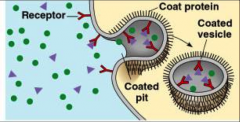
|
|
|
Receptor-Mediated Endocytosis, e.g. LDL
|
watch video on cd
|
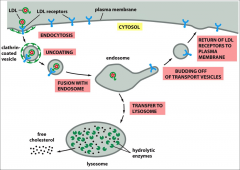
|
|
|
What are hydrolytic enzymes?
|
In lysosomes that digest the particles of LDL. This creates what?
|
Free cholesterol
|
|
|
Lysosomes are the site of cellular ________.
|
Digestion
|
|

